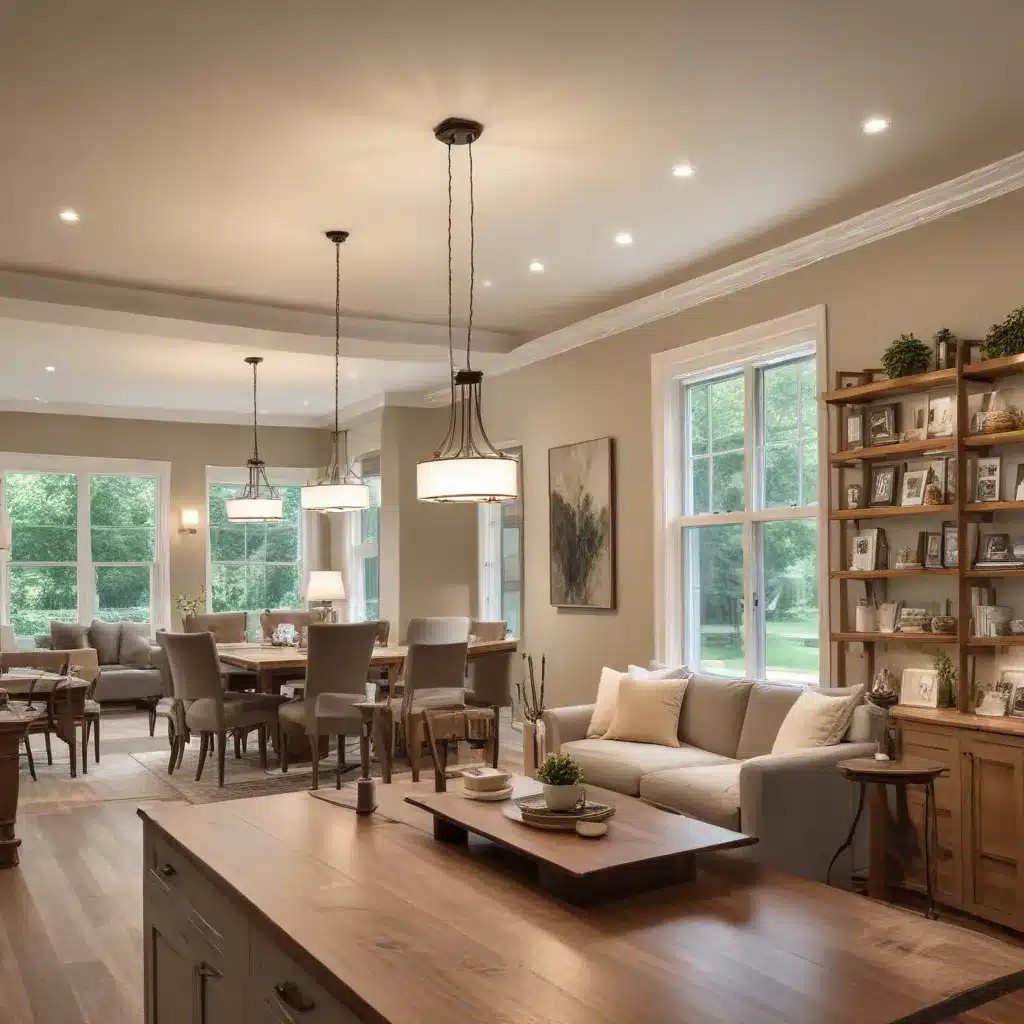
As an experienced home improvement consultant, I’ve seen firsthand the transformative power of strategic lighting upgrades. Whether you’re undertaking a full-scale renovation or just looking to refresh a few key spaces, optimizing your home’s energy-efficient lighting can deliver remarkable benefits – from slashing your electricity bills to enhancing the overall ambiance and functionality of your living spaces.
The Benefits of Energy-Efficient Lighting Upgrades
Reduced Energy Consumption
One of the primary advantages of incorporating energy-efficient lighting into your remodeling project is the significant reduction in energy consumption. LED (light-emitting diode) bulbs and compact fluorescent lamps (CFLs) use up to 75% less energy than traditional incandescent bulbs, making them a smart, eco-friendly choice. By swapping out old, inefficient lighting fixtures throughout your home, you can dramatically lower your overall energy usage and carbon footprint.
Lower Electricity Bills
The energy savings from energy-efficient lighting upgrades directly translate to lower monthly electricity bills. According to the ENERGY STAR program, upgrading just four light bulbs in your most frequently used fixtures can save you up to $120 over the lifetime of those bulbs. Over the course of a full home renovation, these compounding savings can be truly remarkable.
Environmental Impact
Beyond the financial benefits, energy-efficient lighting also has a positive environmental impact. By cutting down on electricity usage, you’re reducing the demand for fossil fuel-generated power, which in turn lowers greenhouse gas emissions and supports a cleaner, more sustainable future. This aligns perfectly with the growing emphasis on eco-friendly home improvement practices – a trend that savvy renovators are eager to embrace.
Lighting Options for a Remodeled Home
When it comes to selecting energy-efficient lighting for your remodeled home, you have several compelling options to consider:
LED Lighting
Light-emitting diode (LED) bulbs have emerged as the gold standard in energy-efficient lighting. LEDs boast impressive longevity, with an average lifespan of 25,000 to 50,000 hours – far exceeding the 1,000 to 2,000 hours of a typical incandescent bulb. In addition to their impressive energy efficiency (using up to 80% less energy than incandescents), LEDs also offer superior light quality, instant-on performance, and a wide range of color temperatures and styles to suit any design aesthetic.
Compact Fluorescent Lamps (CFLs)
Compact fluorescent lamps (CFLs) are another energy-efficient lighting option worth considering. While not as advanced as LED technology, CFLs still use approximately 25-35% less energy than traditional incandescent bulbs. They also have a longer lifespan, typically lasting 8,000 to 15,000 hours. CFLs come in a variety of shapes and sizes, making them a versatile choice for recessed lighting, table lamps, and more.
Halogen Bulbs
For those seeking a middle ground between incandescents and more advanced LED or CFL options, halogen bulbs can be a suitable compromise. Halogen bulbs use 25-30% less energy than standard incandescents while providing a similar warm, familiar light output. While not as efficient as LEDs or CFLs, halogen bulbs can be a cost-effective upgrade, especially for fixtures or applications where the lifespan and energy savings of other technologies may not be as critical.
Factors to Consider in Lighting Selection
When choosing energy-efficient lighting solutions for your remodeled home, there are several key factors to keep in mind:
Room Size and Layout
The size and configuration of the spaces you’re upgrading will play a crucial role in determining the most appropriate lighting fixtures and bulb types. Factors like ceiling height, room dimensions, and the placement of doors, windows, and furniture will all influence your lighting needs. A well-planned lighting design can enhance the functionality and ambiance of any room.
Lighting Needs and Preferences
Consider the specific lighting requirements for each space – whether you need task lighting for a home office, ambient lighting for a cozy living room, or a combination of both. Additionally, think about your personal preferences, such as color temperature (warm vs. cool tones) and the desired brightness levels.
Aesthetics and Design
While energy efficiency is a top priority, it’s important not to overlook the visual appeal of your lighting choices. Integrate fixtures that complement your overall design aesthetic, whether that’s a sleek, modern look or a more traditional, vintage-inspired vibe. The right lighting can be a powerful design element, enhancing the overall feel and personality of your remodeled spaces.
Implementing Lighting Upgrades
Planning and Budgeting
As with any home renovation project, thorough planning and budgeting are essential for a successful lighting upgrade. Start by assessing your current lighting situation, identifying areas for improvement, and researching the various energy-efficient options available. Carefully consider the costs of both the fixtures and bulbs, as well as any necessary electrical work or installation fees.
Installation and Maintenance
Depending on the scope of your lighting upgrades, you may be able to handle some of the installation tasks yourself. However, for more complex electrical work or the replacement of old, hardwired fixtures, it’s often best to enlist the help of a licensed electrician. They can ensure the safe and proper installation of your new energy-efficient lighting, as well as provide guidance on ongoing maintenance and bulb replacement.
Optimizing Energy Savings
To maximize the energy-saving potential of your lighting upgrades, be sure to take advantage of any available rebates or incentives from your local utility company or state energy efficiency programs. The ENERGY STAR website is a great resource for finding such opportunities. Additionally, consider incorporating smart home technology, such as occupancy sensors and dimmers, to further optimize your energy usage and create a more personalized lighting experience.
By incorporating energy-efficient lighting solutions into your home remodeling project, you can not only save on your monthly electricity bills but also contribute to a more sustainable future. Whether you opt for the latest LED technology or a more budget-friendly CFL alternative, the benefits of upgrading your lighting will be felt for years to come. To learn more about other eco-friendly and cost-saving home improvement strategies, be sure to explore the wealth of resources available on Reluctant Renovator.



